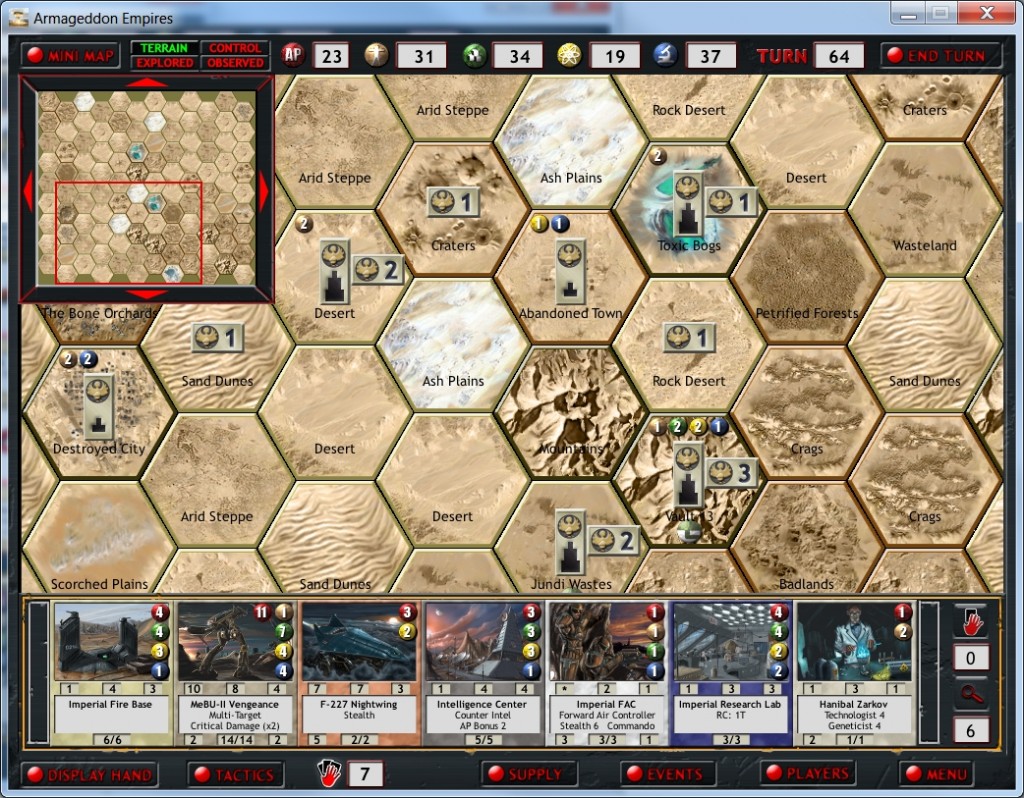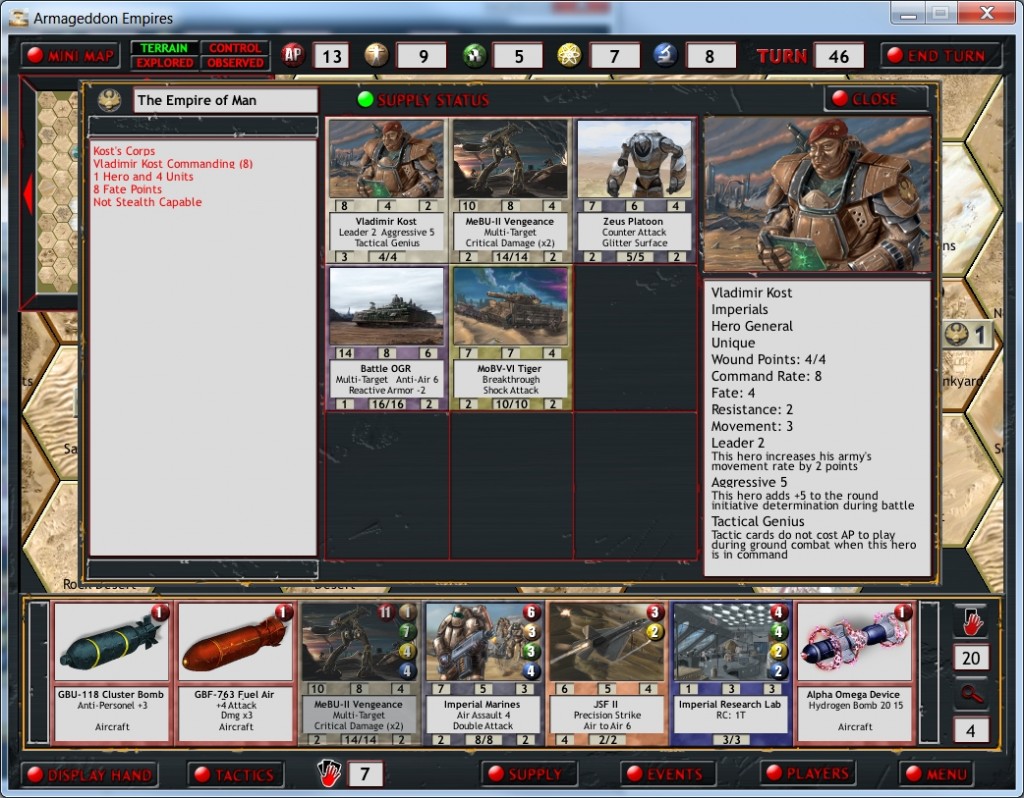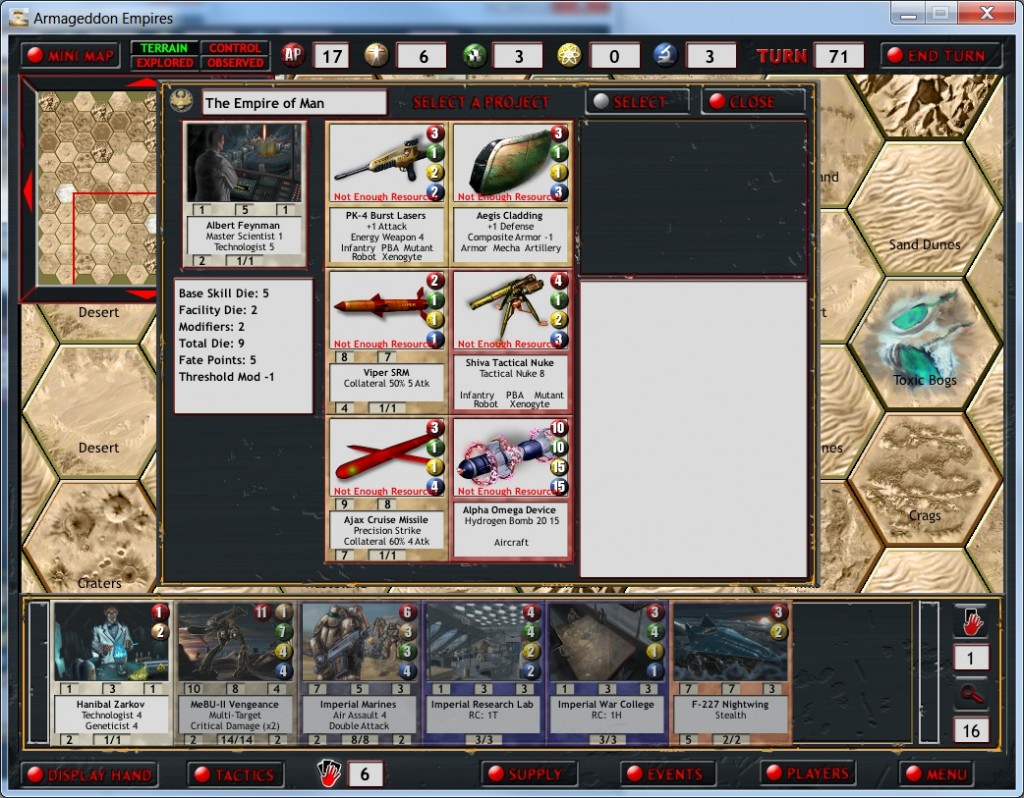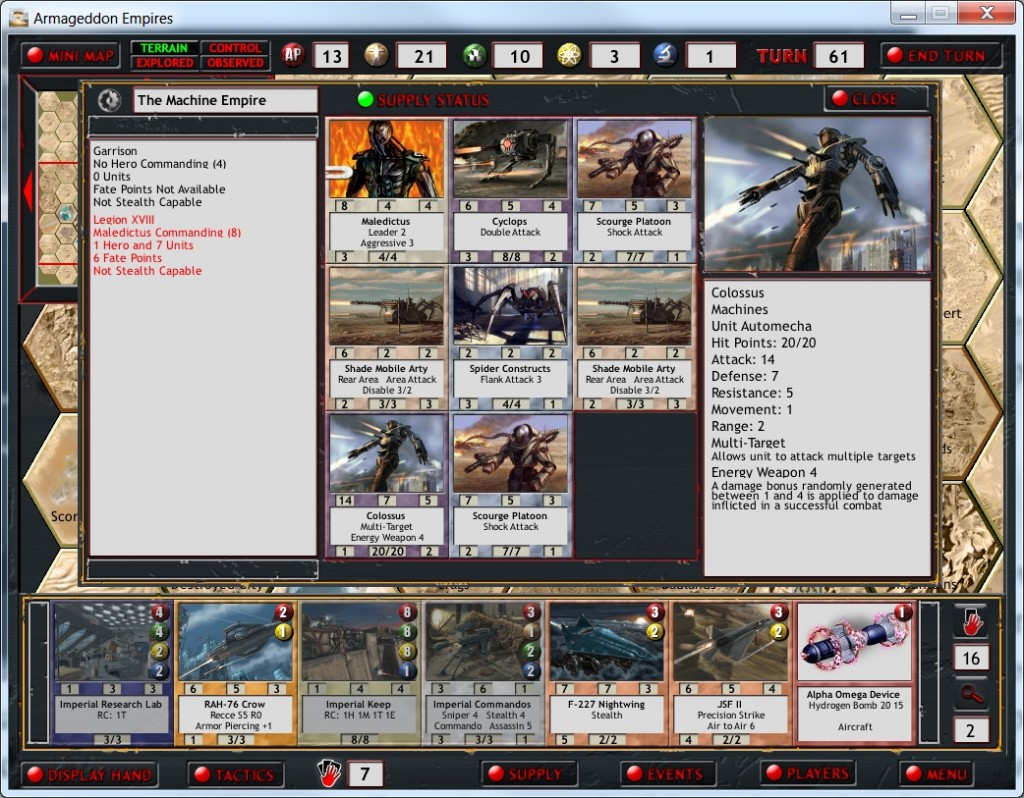
Two high-profile strategy games came out recently, Civilization V: Gods and Kings and Sins of a Solar Empire: Rebellion, and I might as well spoil my forthcoming reviews by saying I like both of them. Each offers incremental but tangible improvements over its predecessor; each is a worthy addition to its franchise. However, for sheer enjoyment, they might just be trumped by a third title I discovered around the same time: Armageddon Empires, the 2007 board/collectible card game-inspired, turn-based strategy title from Vic Davis and his one-man studio Cryptic Comet.
By way of background, AE takes place on a future Earth devastated by a four-way war between humans, mutants, and two invading alien armies. Players explore a randomly generated map, gather resources, amass armies and heroes, research better equipment, and ultimately crush their opponents. In other words, AE is a 4X (explore, expand, exploit, exterminate) game, the post-apocalypse’s answer to Civilization. However, whereas conventional 4X games allow players to build anything they have researched and can afford, AE represents available units and structures as cards – players are limited to building what they have in their hand at any one time. Certain card types can be created and added to a hand in mid-match, but the basic building blocks of gameplay – tanks, troops, fortresses, heroes – must be included in a deck before a match (hence the board game/CCG element)*.
That’s the waiter’s description – so what are the chef’s secrets?

The first thing that makes AE special is its twist on the genre formula: most strategy games are built around sprawl, but AE is built around scarcity. Most of the wasteland is just that, useless and barren, save for a few resource-gathering sites. Armies are finite, limited by deck size. New units are produced from one source (the player’s hand of cards – though they can then be deployed to any friendly base), so no juggling multiple cities, factories, or build queues. This has several implications. First, as Kieron Gillen pointed out, it’s consistent with the game’s post-apocalyptic theme: it stands to reason that in this world, there just is not that much to go around. Second, it does away with the usual bane of the strategy genre, the “I have to babysit all this?!” syndrome. Last of all, when players can form a stack of doom out of four units (see the screenshot above) and (at least on the default settings) there are no more than two or three main armies to manage, this doesn’t just affect the gameplay mechanics (“fewer, but more interesting decisions”) – it also makes every stack more distinct, and hence easier to identify, easier to grow attached to. (This is a topic to which I’ll return.)
AE’s second distinctive feature is that, like Distant Worlds and Conquest of Elysium 3, it gets exploration right. Every game map is bound to contain a few special locations (the number can be tweaked at startup), and these run the gamut. Named, especially juicy resource-gathering sites: the Camps (+3 manpower, whoo!), the Slave Pit and its overseers, the cannibal-infested Destroyed City. Abandoned strongholds: the White Base**, the Crashed Mothership, the Mecha Design Lab. Hidden goodies: a desiccated corpse still clutching a suitcase nuke. This works from a mechanical perspective: it encourages early-game exploration, rewards players for investing in recon units, and offers a trade-off: do I muster troops to take out a defended site, or do I use them to hit one of the other players? But crucially, it also adds to the theme. Scavenging is part and parcel of any post-apocalyptic world, and AE’s specific choice of locations adds further flavour. What do the slave pits and cannibal ruins tell us about the catastrophe that befell the world? What does the gaudy casino defended by gangsters tell us about how some survivors have managed to make their living? And just who was that poor devil with the suitcase nuke?

The third element that makes AE special is the broadest and most intangible of the three, but also possibly the most important: this game is evocative. For me, every single-player video game is at least partly an exercise in imagination, in temporarily convincing me that I’m not just making pixels blink on a screen – I’m building a city, piloting a spaceship, saving the world. And this is where AE shines. Partly, this is thanks to the factors I discussed above. Exploration brings the game’s world alive, and the relative scarcity of pieces in play means that (a little like a squad-based game or tactical RPG) it’s easy to construct narratives about the Vengeance mech you always sent where the fighting was fiercest, or the plucky marines who seized the alien HQ with a surprise landing. Partly, this is due to the way so many game mechanics revolve around hero units, giving AE a human face. New inventions (see the above screenshot – better vehicle armour, man-portable laser cannon, tactical and strategic nukes…) don’t spring from a well of “science points” – they come from scientist heroes, who have to roll dice against their skills. That suitcase nuke won’t magically walk to another player’s base – a saboteur hero, such as the humans’ Valentine Kusanagi**, has to infiltrate the hex and make a successful roll. Partly, this is due to inspired card art. The Colossus mech is one of the scariest units in the game, and to see why, look at the screenshot below. That thing has to be the size of a skyscraper! Partly, it’s due to the way different game mechanics interact in clear and intuitive ways: my scouts found a nest of survivors in a destroyed city, which let me call in a tactician and some Imperial Marines, who secured a forward outpost, which I used as an airbase to launch a nuclear strike and win the game. Partly, it’s due to… I could go on, but the point is AE is so much more than the sum of its parts. I walk away from every match feeling like I enacted a heroic story, and that’s one of the best things I can say about a game.

One might wonder why, if AE is so good and has been around for five years, it isn’t also better known. To be sure, it’s not perfect. There’s no in-game tutorial, and while it’s a rare game whose controls I can’t figure out just by messing around, AE’s are sufficiently unintuitive to require reading the manual or a how-to-play guide (I recommend Bill Harris’). Its interface leaves something to be desired, even by indie strategy game standards, and so does its coding – I’ve had to abandon a couple of matches due to glitches. But I don’t think the problem is the rough edges – none of them seriously hurts the gameplay. I think the problem is precisely that AE has been around for five years. It was very much ahead of its time: despite its glowing critical reception, it was not only a TBS, but an indie TBS for the PC, in the days before iPads, hip indie bundles, and the recent renaissance of small/mid-market games.
And that really is a shame, because five years on, AE doesn’t just “hold up” – it shines as an example of what this genre can do. More than a very good game, more than a possibly great game, AE is a unique game, packed with lessons in design. This is one game I think every strategy aficionado, and certainly every strategy designer, should play.
* There are a couple of exceptions, but this holds true as a general rule.
** I also like the shout-outs that Vic Davis scattered throughout the game!
Resources
Official website, where you can download a demo or buy the game
How-to-play guide, by Bill Harris
We hope you enjoyed this retrospective! To quickly find this post, and others like it, click the“features” tab at the top of this page.
Discover more from Matchsticks for my Eyes
Subscribe to get the latest posts sent to your email.
It’s good to see someone writing about one of my favorite strategy games ever. Armageddon Empires is a great game, one that I wish more people knew about. Thanks for writing this!
By the way, Vic Davis mentioned this article in his blog, and I hope to see you writing something about Occult Chronicles soon enough. Cheers!
Thanks Wolfox — glad you liked the article! I remember a friend of mine kept trying to sell me on Armageddon Empires for years — good thing I finally took his advice. ;)
Yep, I saw Vic’s mention. I’ll be sure to check out Occult Chronicles, too. :D
Very good analysis.
My brother bought me this game a few monthes ago, and since then, i felt this game “could have been good”. Yes, could, it’s almost there.
So what’s missing ?
You already mentioned the relatively unintuitive interface (i would even say illogical sometimes), and absence of tutorial / explanation,
but what you did not mention the poor execrable AI, and the absence of difficulty level.
This absence is not compensated by any multiplayer mode.
Since this game is only vs AI, if the AI is crap, it considerably limits the replayability of the game.
So sure, in spite of this, i’ve played the game several times, since i liked the atmostphere. But consistently beating the opponents with such a large margin, well, i was sometimes wondering if they even moved or done anything useful during the game.
Unfortunately, the developper is unresponsive, in spite of the continued sales of its title.
Seeing that the last update is from 2008, one can logically expect this game to remain in its current form.
It’s a bit of a pity, since it’s “almost there”, almost excellent.
And yes, i believe these flaws are what made the title “not as well distributed as it should”. In the end, word of mouth does also matter.
Cyan I’m sorry to hear you didn’t enjoy the game as much as I did. I actually found the AI to be right in the sweet spot for me – weak enough that I could always win (the only matches I didn’t win are those that glitched out on me), but good enough that I felt I always had to work for my victory. In any case, thanks for commenting!
One of the great games I ever played except that I never could find a place to buy the full version but yet I still enjoyed the demo big time. I’m in South Africa and if anyone knows where I could buy this game please email me at mzwa@tuluntulu.com
Can you buy from the developer’s site, Mzwa? That was where I purchased my copy.